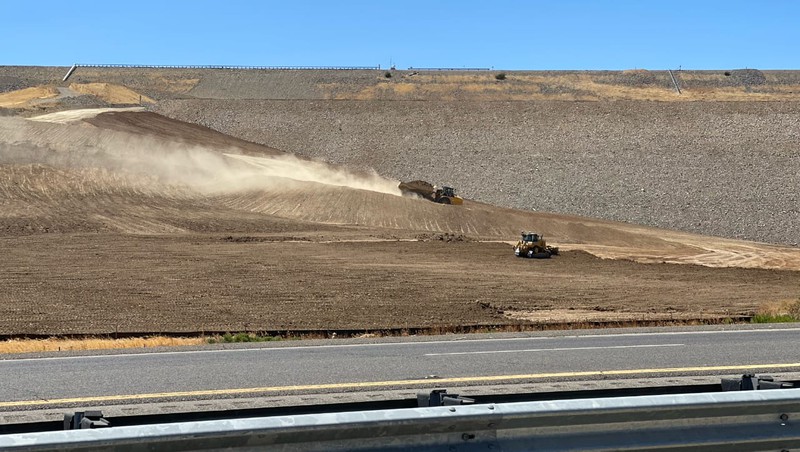We check in on efforts to raise some dams in the state to store more water, and to raze some dams to to let water run free.

Tens of thousands of truck loads of earth will be moved to raise the B.F. Sisk Dam by ten feet. Chris Neklason contributed
Three Go Up
Completed in 1967 by the federal Central Valley Project, the San Luis Reservoir has a storage capacity of 2,042,000 acre-feet of water and is the fifth largest reservoir in California. Located in Merced County, it is a vast landmark for motorists on the adjacent Highway 152 linking the Central Coast to the Central Valley.
Since the beginning of the year, commuters and travelers might have noticed a caravan of heavy dump trucks hauling loads of earth to waiting bulldozers that are spreading the dirt out at the base of the dam, slowly raising the level of the ground imperceptibly with every load.
It’s part of a $1 billion project to fortify the B.F Sisk Dam against earthquakes and raise it by 10 feet to store an additional 130,000 acre-feet of water, projected to be completed in 2032. The additional storage isn’t for “new” uses or customers; it’s one of a number of projects statewide initiated to store more water against projected future shortfalls caused by the climate change-induced aridification of California.
Those projects include the construction of a new dam straddling Glenn and Colusa Counties in Northern California—the Sites Reservoir Project, which is the first new dam to be built in California in decades. This project, located 70 miles north of Sacramento, will deliver water to San Bernardino County.
Like the San Luis, the nation’s largest off-stream reservoir, the Sites will not be stream-fed. Instead, it will store up to 1.5 million acre-feet of excess stormwater pumped from the Sacramento River for use during drought years.
The Sites Project is inching forward, having first cleared a legal hurdle in June 2024, when a federal judge dismissed an environmental lawsuit. It is now going through the state Water Resources Control Board water rights permit process. Public hearings were held in the fall of 2024 along with an open 60-day public comment period. A ruling is expected in early 2025. In December 2024, Governor Gavin Newsom held a press conference in Colusa County near the proposed reservoir, urging completion of the permitting process and commencement of construction.
There’s an irony in the tons of carbon belched into the air by the armada of dump trucks fetching and delivering the loads of earth required to raise the one dam at San Luis and build the other two required for Sites. Both reservoirs are deemed necessary as a hedge against the climate change caused, in small part, by their construction.
Four Come Down
The end of the largest dam removal effort in US history was celebrated in September as the project to take down the last of four dams on the lower Klamath River wrapped up and the river ran free for the first time in more than 100 years.
The Iron Gate Dam, Copco Dams 1 and 2, and J C Boyle Dam were constructed by energy giant PacifiCorp to generate electricity in the early 1900’s. This had a disastrous effect on the lives and livelihoods of the native Yurok people, who have inhabited the region for centuries, and on the migration and spawning cycles of coho and chinook salmon. Following decades of advocacy by the tribe and environmental allies, the federal government approved the razing of the dams in 2022. California allocated about half of the necessary funding for the removals from 2014’s Proposition 1 water bond measure, with the other half coming from surcharges to PacifiCorp customers.
With the dams removed, the real work has begun. The Yurok are now working on restoring the river channel and the drained reservoirs. And in October 2024, Oregon Department of Fish biologists announced the identification of an autumn-run Chinook salmon upstream of where the J C Boyle dam had once stood, the first in over 100 years.
Our Complicated Relationship With Water
California is home to the largest and most complex water system in the world, constructed to manage flooding, provide water to the farms feeding the world and to the concentration of people residing in the arid southern portion of the state. The dams in the system are central to that effort.
The dams on the Klamath, though, were built not to harvest the water but to harness it to create electricity. In the end, it wasn’t even a lot of electricity, certainly not worth the century-long toll on the salmon or the Yurok, and the dams were taken down and today the Klamath runs free.
It’s good to know that even as we’re burning oil to make water for the future, our system can admit and correct mistakes of the past. It remains to be seen, though, if damming the Klamath for a hundred years didn’t damn it for all time.
Short articles summarizing reporting by local news sources with linkbacks to the original content.